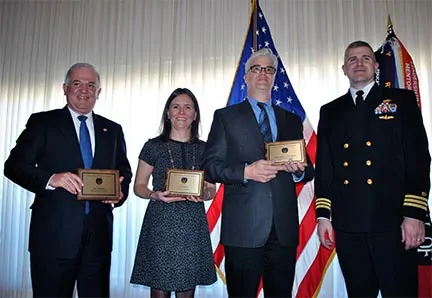

SCS Management Services™ helps many of our clients’ incorporate economic planning, financial analysis, and feasibility studies into their master planning and have requested copies of our articles. All can be found and filtered by topic area, and we are always ready to help you find the information you need.
Our articles may be printed or shared using the icons on the left navigation bar. Or, you may share or email this page to keep it handy. SCS respects your privacy; we do not monitor or collect your email address or information.
Contact Vita Quinn for more information. Ms. Quinn is SCS Engineers’ National Expert on Solid Waste Finance and Rate Studies. She has 12 years of experience as a financial analyst and management consultant. She has extensive experience working for local government and has developed financial sustainability solutions for various general governments, special revenue funds, and utility enterprise funds. Ms. Quinn has an MBA in Finance and a Bachelor’s Degree in International Economics.

Residential Automated Collection Makes Sense for Idaho Falls
The Nuts and Bolts of Implementing a Residential Automated Collection Program
Conducting a Rate Analysis as Part of a Master Plan Study in Killeen, Texas
https://www.scsengineers.com/scs-articles/conducting-a-rate-analysis-as-part-of-a-master-plan-study/

Conducting Solid Waste Rate Studies and Business Plans
https://www.scsengineers.com/conducting-solid-waste-rate-studies-and-business-plans/
Get a Firm Handle on Solid Waste Costs to Optimize Performance
https://www.scsengineers.com/get-a-firm-handle-on-solid-waste-costs-to-optimize-performance/
Cash Flow Analysis Forestalls Long-Term Debt
Is Privatization the Answer? You Need to Consider Several Factors Before Making the Decision for Solid Waste Services
https://www.scsengineers.com/publications/articles/page/11/
Developing a Strategic Business Plan for Your Agency
Economic Feasibility 101 – Understanding the Tools of the Trade
Assessing a Solid Waste Agency’s Financial Health
Are Your Rates Correct? Collection and Disposal Rate Studies are a Valuable Tool
Integrating Financial Analysis into Solid Waste Operations Planning

Recycling Trends in the United States
https://www.scsengineers.com/scs-articles/6555/

Anaerobic Digester Economics
Give SCS a call or send an email to if you have questions. Find your local office here: https://www.scsengineers.com/locations/. Visit our Solid Waste Planning Services page for additional information, articles, whitepapers, and case studies.
Increasingly, solid waste and recycling agencies are being asked by their political decision makers to improve efficiency, focus on customers, and reduce increased costs. Many agencies are managed with a combination of manual processes, desktop computer tools, limited vehicle and cart tracking and management tools, and custom databases. While effective, these methodologies often entail more effort, labor, and costs.
Smart technologies are expected to grow substantially over the next decade as agencies attempt to minimize their overall costs in solid waste collection and recycling and increase overall efficiency. As discussed briefly in this article, smart technologies have advantages and disadvantages. As agencies investigate technology to help support their service, ensure continued quality service delivery and meet demanding business requirements, it is important to conduct feasibility assessments to evaluate the economic costs to implement and update the use of new technologies in a sustainable manner.
Marc J. Rogoff and Laurel Urena of SCS Engineers.
What makes Sol shine so brightly?
For Solavann Sim it’s his positive qualities as an individual and his ability to work effectively using a multidisciplinary approach with his clients. Our industry’s strongest and most respected leaders are those who are considered collaborative, not fixated on making all decisions themselves or working in a silo. On the contrary, innovation happens at the crossroads of different disciplines and that is where Sol shines brightest.
Sol’s landfill gas design-build and operations experience, along with his knowledge of hydrogen sulfide treatment programs, help prevent and mitigate potential problems quickly. His comprehensive technical and field competence, along with his clients, and his team comprised of staff in several disciplines approach solutions in various ways; each having unique perspectives but a common goal. Working collaboratively with clients the team solves complex challenges facing landfill owners and operators. Innovative solutions are often found where perspectives, ideas, and fields of expertise meet.
Read more about Solavann Sim and SCS Engineers LFG programs here.
See SCS’s 40+ years of innovative thinking at SCS Firsts an interactive list of client solutions, underneath News, Events, and Blogs.
Read and share the full article by David Greene, PE, here.
EPA recently established expansive new air rules affecting MSW Landfills. Implementation of the new rules places new responsibilities on both the regulated community and regulators alike. However, some of these responsibilities are unclear and have created unresolved issues that should be addressed in close consultation now with your state/local regulatory authority.
For example, if a landfill is “new,” the facility is now subject to NSPS Subpart XXX, which is fully effective. A design capacity and NMOC emissions rate report should already have been submitted.
If NMOC emissions from a facility exceed 34 Mg/yr, then the landfill will need to submit a GCCS design plan within 12 months of the date of exceedance and install and operate within 30 months (no later than May 2019 for those triggering with the promulgation of the rule). If a landfill is an “existing emissions source,” it will be subject to the new EG rule (Subpart Cf).
Landfill owners should maintain close contact with their state/local regulatory authority regarding the status of the regulator’s state implementation plan, due by November 2017. That state implementation plan will prescribe the required compliance dates for an existing landfill, likely to be no later than the 2018/2020 time period. In either case, owners should become familiar with the rule and stayed tuned as compliance guidance evolves to address the unresolved issues.
Contact SCS Engineers to discuss the regulatory status in your state at , or call your local representative.
Are you approaching the required five-year review/plan re-certification for your facility’s Spill Prevention, Control, and Countermeasure (SPCC) Plan? Even if you’ve been through several cycles of performing five-year tune-ups on your SPCC Plan, you can make your next review easier and prepare yourself for future SPCC Plan re-certifications if you follow these five tips.
Start Early
Late renewals are a consistent pain point for many companies. To avoid being late with your next re-certification, start your review six months before your SPCC Plan is due for its 5-year review. If you are conducting the review internally, start by identifying the person who will be doing the review. If you are using a third party, this approach will help you go through the proposal/contracting process, so you are ready to conduct the actual review and complete the re-certification before the Plan expires.
Simplify Data Collection
One of the keys to a compliant SPCC Plan is to collect accurate data in the field about your facility’s oil sources. Streamlined data collection is of particular importance if you have a large facility or your oil storage changes regularly. The key to simplifying data collection is to make sure your reviewer has organized information to evaluate the compliance aspects of each source. Accurate data collection can limit the follow-up required from plan preparers to verify information, as well as minimize the potential for discrepancies. Moreover, particularly useful if a third party is auditing your Plan or if it is in review during an EPA inspection.
Reduce Redundancy with a Summary Table
One way to simplify your Plan is to use an oil source summary table to cover as much information as possible. A table can include each oil source and the aspects of how the oil source is compliant with the SPCC Rule. There may be areas in the Plan where you need to provide additional text discussion regarding oil sources to explain a compliance matter. In general, try to avoid duplicating information within the Plan.
Watch Out for Commonly Overlooked Areas
While secondary containment and overfill protection are key elements to review at each oil source, some reviewers forget to measure the size of containment structures. Dimensions need to be carefully measured in the field to verify and show sufficient secondary containment capacity in your facility’s SPCC Plan.
Another commonly overlooked area is facility drainage; specifically the overland flow in the proximity of each oil source, which is key to determining the potential receptors where spilled product can travel. These receptors could be storm sewers, ditches, wetlands, or waterways. You can discuss the protection of these receptors during your facility’s annual SPCC training. Swift action and concise communication during a spill can help limit your liability.
Use Targeted Annual Training
Many companies struggle to comply with the annual training requirement. One of the tripping points is trying to train all employees who handle oil for example. To avoid this pitfall, implement a tiered training program so you can focus the training content based on an employee’s responsibility level.
Spill recognition and notification through proper internal channels to get a spill cleaned up is an essential message for employees that occasionally handle oil. These employees could also be trained to aid with the initial control and response to a spill. A second tier may include team members who manage the SPCC Plan; they have additional responsibilities such as inspections of oil sources and spill reporting.
By Chris Jimieson, SCS Engineers
Chris Jimieson has over 17 years of experience supporting industrial, commercial, military, federal, state, municipal, and solid waste companies with environmental compliance. He has extensive experience building and reviewing SPCC and Storm Water Pollution Prevention Plans (SWPPP) and manages compliance assignments, providing computer-based training modules to meet employer training needs. Contact Chris at or 608-216-7367.
The Society of American Military Engineers recognized SCS Engineers for their 15 years of service and volunteer support at the District of Columbia post this month. The award was presented by Commander Craig Clutts of the US Navy, the Outgoing DC Post President.
On hand to receive the award for SCS was John Tabella, PG, LEED AP®, National Expert for Environmental Due Diligence and for Federal Services; Heather Blake (pictured), Federal Marketing Coordinator, and Dave Hostetter, PE, LEED AP®, and CEM at SCS Engineers.

SCS Engineers has a very long track record of solving environmental and energy management, solid waste, hazardous waste, water, and air compliance challenges. Approaches we pioneered include risk-based cleanups, voluntary cleanups, accelerated investigations, presumptive and sustainable remedies, environmental management systems, energy systems, and waste minimization. These approaches are at the forefront of local and Federal environmental and energy programs today.
SCS provides professional engineering and scientific services with a focus on environmental protection and conservation of resources. Our clients come back because we find practical approaches to even the most complex environmental challenges.
The authors of this white paper entitled “Collapsing Range of an Endemic Great Plains Minnow, Peppered Chub Macrhybopsis tetranema,” examine range-wide declines in both abundance and distribution of the Peppered Chub from habitat loss and fragmentation.
Habitat loss and fragmentation include dams, loss of perineal flows, and alteration of flow regimes (flooding). These habitat alterations impact the spawning needs of pelagic-spawning fish and jeopardize the survivability of this species within its historical range. It is estimated that the Peppered Chub has been extirpated from more than 90% of its historic range.
A recovery plan for the Peppered Chub might consider restoration and maintenance of adequate seasonal fluctuating river flows, removal of barriers, and repatriation to river reaches that have experienced extirpation.
The authors suggest repatriation or supplemental stocking as is done elsewhere for small- bodied cyprinids as a necessary first step in recovery, but this alone might not be sustainable or sufficient without taking the proper actions to remedy habitat deficiencies. Specifically, removing or modifying to allow fish passage the remaining barriers impeding upstream recolonization of rivers throughout the species’ historical range and maintaining adequate seasonal river flows to support juvenile survival is likely necessary for recruitment.
Construction of a fish passage structure on the Arkansas River in Wichita, Kansas was recently completed in 2010. This fish passage was built with the passage of small-bodied fishes as a primary function and has already allowed for the recolonization of Emerald Shiner Notropis atherinoides into a reach of river from which the species was previously extirpated. This suggests that fish passage structures such as this can restore upstream connectivity for small-bodied Great Plains fishes.
The Authors:
CASEY A. PENNOCK and KEITH B. GIDO
Division of Biology, Kansas State University, Manhattan 66506
JOSHUAH S. PERKIN
Department of Biology, Tennessee Technological University, Cookeville 38505
VAUGHN D. WEAVER
SCS Engineers, Wichita, Kansas 67226
STEPHEN R. DAVENPORT
U.S. Fish and Wildlife Service, New Mexico Fish and Wildlife Conservation Office, Albuquerque 87109
JOHN M. CALDWELL
New Mexico Department of Game and Fish, Santa Fe 87504
EPA is proposing a GHG SER of 75,000 tons per year (tpy) Carbon Dioxide equivalent (CO2e) and requesting comment on it as well as two lower levels, specifically 30,000 tpy and 45,000 tpy CO2e, respectively.
The Associations do not believe there is sufficient information to support lowering the GHG SER below the proposed 75,000 tpy CO2e level and provided a table utilizing equivalent criteria pollutants from combustion sources (i.e., NOx, CO) yields CO2 emissions as high as 780,000 tpy CO2.
EPA already concluded in USEPA, Proposed PSD Revisions Rule, 81 FR 68137 that the burdens of regulation at a GHG SER level between 30,000 and 75,000 tpy CO2e would yield a gain of trivial or no value from both a programmatic and individual project-level perspective. Therefore, NWRA and SWANA strongly recommend EPA retain proposed GHG SER of 75,000 CO2e (or higher), and resist pressure to lower the GHG SER.
On the Topic of Biogenic GHG Emissions, the EPA’s final rule requires clarification to remain consistent with previous documentation and research to prevent significant permitting delays and increased costs that will not result in meaningful emission reductions.
The Associations encourage the EPA to ensure that waste-derived biogenic CO2 (e.g., from municipal solid waste (MSW) landfills) is treated as carbon neutral under the final PSD Permitting Revisions Rule to be consistent with prior Agency determinations specified in this memorandum and documents as follows:S. EPA, Memorandum Addressing Biogenic Carbon Dioxide Emissions from Stationary Sources, McCabe, Janet, November 19, 2014.
S. EPA, Memorandum Addressing Biogenic Carbon Dioxide Emissions from Stationary Sources, McCabe, Janet, November 19, 2014. The documents highlight waste-derived, biogenic CO2 as a type of “carbon neutral” feedstock based on the conclusions supported by a variety of technical studies and conclusions of the Agency’s latest draft Framework for Assessing Biogenic Carbon Dioxide for Stationary Sources, which was released with the memo. The Agency memo stated that “the Agency expects to recognize the biogenic CO2 emissions and climate policy benefits of such feedstocks in [the] implementation of the CPP.”
US EPA, Emission Guidelines for EGUs, 80 FR 64855. Both the revised Framework, and the EPA’s Scientific Advisory Board (SAB) peer review of the 2011 Draft Framework, found “that the use of biomass feedstocks derived from the decomposition of biogenic waste in landfills, compost facilities, or anaerobic digesters did not constitute a net contribution of biogenic CO2 emissions to the atmosphere.”
S. EPA, Appendix N. of Revised Framework for Assessing biogenic Carbon Dioxide for Stationary Sources, November 2014, pg. N-25. In Appendix N. of the Framework, entitled Emissions from Waste-Derived Biogenic Feedstocks, EPA calculated negative Biogenic Accounting Factors (BAF) for various examples of treatment of landfill gas via collection and combustion. EPA explains, “Negative BAF values indicate that combustion of collected landfill gas feedstock by a stationary source results in a net CO2e emissions reduction relative to releasing collected gas without treatment.”
US EPA, Carbon Pollution Emission Guidelines for Existing Stationary Sources: Electric Generating Units; Final Rule [Emission Guidelines for EGUs], 80 FR 64885. “[T]he use of some biomass-derived fuels can play a role in controlling increases of [in] CO2 levels in the atmosph The use of some kinds of biomass has the potential to offer a wide range of environmental benefits, including carbon benefits.”
US EPA, Emission Guidelines for EGUs, 80 FR 94855. Types of waste-derived biogenic feedstocks may include: landfill gas generated through decomposition of MSW [municipal solid waste] in a landfill; biogas generated from the decomposition of livestock waste, biogenic MSW, and/or other food waste in an anaerobic digester; biogas generated through the treatment of waste water, due to the anaerobic decomposition of biological materials; livestock waste; and the biogenic fraction of MSW at waste-to-energy facilities.
NWRA and SWANA believe the final PSD Revisions document should follow the approach to waste-derived feedstocks enshrined in the Final Clean Power Plan, and as recommended by the SAB, and ensure that waste-derived biogenic CO2 is treated as carbon neutral. Based on EPA’s own lifecycle assessments for the Renewable Fuels Standard program, its U.S. GHG Inventory, and confirmed by the SAB, EPA has sufficient analysis to support exclusion of selected categories of biogenic emissions from PSD permitting, including those from managing landfill gas and organic components of MSW.
The EPA does not seem to consider the regulatory treatment of biogenic CO2 from stationary sources to be a key issue in the context of the PSD revisions rule, based on a comment found in a Summary of Interagency Working Comments on Draft Language. Instead, the EPA continues to believe this rulemaking to establish a GHG SER under the PSD program is not the appropriate venue to address the broader concern of the regulatory treatment of biogenic CO2 from stationary sources.
The Associations strongly disagree and are concerned that because EPA remains silent on this important issue, some permitting authorities might improperly require landfills to incorporate biogenic CO2 emissions in the PSD permitting process. Historically, few landfills triggered PSD because non-methane organics emissions rarely reached the threshold. However, if biogenic CO2 emissions become subject to PSD, many landfill projects, which are “anyway sources” due to renewable energy projects, would also be forced to do BACT analysis for GHG. Biogenic CO2 is emitted from:
From the perspective of developing new renewable transportation fuel or energy projects, subjecting biogenic emissions from landfills to PSD could be an enormous barrier. The Associations would like the EPA to clarify in its final rule that the emissions of biogenic CO2 from treating or controlling landfill gas does not increase the CO2 levels in the atmosphere, but instead, has positive emission reduction and climate benefits. Failing to clarify this important point could subject landfills to significant permitting delays and increased costs that will result in no meaningful emission reductions.
Questions? Contact SWANA, NWRA, Patrick Sullivan, or your local SCS office.
A typical SCS landfill expansion project contains an engineering evaluation and analyses addressing important technical considerations which include the existing hydrogeologic conditions, global slope stability, Landfill base settlement, geomembrane compression and strain, leachate pipe strength, useful life of the existing infrastructure and utility lines, stormwater management, leachate and landfill gas system expansion.
This case study site, it shows that the vertical or piggyback expansion of a landfill is a unique way of solving landfill airspace shortage problem. Its feasibility is always site specific and depending on the existing waste types, slopes, liners, design capacity of leachate and gas collection, and stormwater management systems. In addition, the landfill design needs to be thoroughly investigated, engineered, and operated.
From the results of the global final slope stability and the landfill base settlement analyses, it concluded that a vertical expansion at the case study landfill will not increase the risk to human health or the environment over the existing regulatory approved conditions. A vertical expansion provides the landfill owner with an opportunity to increase the landfill volume and provide the residents with the maximum service life within the existing footprint of the permitted Landfill. This maximization of available resources does not expand the environmental footprint of the site and provides better environmental protection and at the same time creates a sustainable landfill site.
A vertical expansion provides the landfill owner with an opportunity to increase the landfill volume and provide the residents with the maximum service life within the existing footprint of the permitted Landfill. This maximization of available resources does not expand the environmental footprint of the site and provides better environmental protection and at the same time creates a sustainable landfill site.
This case study was presented at ISWA 2016.
Read and share the complete case study here.
Getting a firm handle on a solid waste operation and expenses is a challenge for any solid waste agency manager or landfill operator. It is particularly imperative in this era of “lean and mean” budgets and looming regulatory policy. Doing more with less is the watchword for most operations across the country still reeling from the financial impacts of the Great Recession.
SCS Engineers has created a package of articles to help you identify if your landfill, landfill gas, or solid waste operation is ready for 2017. We hope this useful guidance will help you plan for the upcoming year. SCS professionals are always available to answer questions and provide advice. Find the office or SCS professional nearest to you by clicking on one the links here: Offices and Professionals.
Download, print or share this package by using the download button under the articles or by using the navigation at left. The package includes the following information written by SCS National Experts: